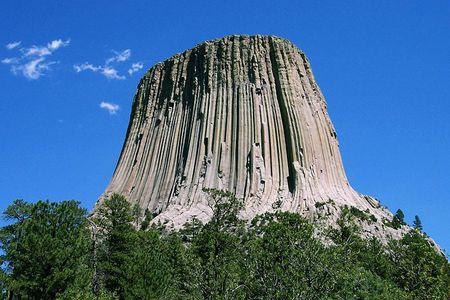Devils Tower National Monument in northeastern Wyoming was proclaimed by President Theodore Roosevelt on September 24, 1906, becoming the very first national monument established under authority of the Antiquities Act. In addition to attracting lots of tourists (322,000 last year) the tower has acted as a magnet for climbers. The tower's columnar jointing (see accompanying photo) offers some of the best crack climbing on the continent.
While climbing the tower is considered a low-impact activity, and therefore permitted as a regulated recreational use of the park, the National Park Service must protect the park's natural and cultural resources. That includes paying heed to Native American cultural values linked to the tower.
Devils Tower is a 1,276-foot high monolith whose surface is divided into large hexagonal columns with hundreds of vertical cracks varying in width and up to 400 feet long. The numerous climbing routes that have been put up on this aesthetically pleasing tower are technical (rated 5.7 to 5.13 in difficulty) and provide enough challenge to give “weekend climbers” a satisfying sense of achievement. The variety of the available routes entices many climbers to make repeat trips to the tower.
Like other national parks offering rock climbing opportunities, Devils Tower employs a Climbing Management Plan to regulate recreational climbing. The original CMP was released in February 1995 and a CMP update was released in April 2006. The update primarily provided for improved climber education, safety standards, and climbing access routes.
The Climbing Management Plan for Devils Tower was designed to enable recreational climbing while protecting natural and cultural resources. Thus, for example, climbers must not install new bolts or pitons, must not leave webbing and other equipment behind, and must avoid using routes closed at certain times to prevent disturbing nesting raptors.
One of the most controversial provisions of the Climbing Management Plan is the voluntary closure of the tower to climbing during the entire month of June as a show of respect for Native American cultural values. June is a culturally significant time for Native Americans because that’s when many ceremonies traditionally occur.
As discussed in a recent Traveler article, Devils Tower is sacred to more than 20 Indian tribes. Many Indians throughout America consider recreational climbing of the tower to be a desecration of the sacred site and a blatant show of disrespect for Native Americans and their belief systems.
Here is the relevant portion of the Devils Tower CMP:
A VOLUNTARY CLOSURE TO CLIMBING IN JUNE
A voluntary closure to climbing at Devils Tower for the entire month of June will be encouraged beginning in 1995. The NPS will not enforce the closure, but will rely on (a) climbers regulating themselves and (b) a new educational program to motivate climbers and other park visitors to comply. The closure zone will include all areas inside the loop of the Tower Trail. Efforts will be made to encourage climbers, hiker/climbers, and anyone else from approaching the tower or wandering off the Tower Trail each year from June 1 through June 30.
The value of a voluntary closure is that individuals can make a personal choice about climbing. Climbers can regulate themselves by deciding if they want to refrain from June climbing out of respect for American Indian cultural values.
The voluntary closure gives the NPS time to conduct an intense cross-cultural education program as part of the broader goals of the FCMP. We are hopeful that a successful cross-cultural education program will lead to better understanding about climbing and the sacred site issue and the values of American Indians, climbers, and the general public. A significant aspect of a successful educational program is developing a better understanding, among all visitors, of the tower as a sacred site and as a recreational resource.
Because the NPS plans to fully comply with the June closure, NPS staff will not climb on the tower in June except to enforce laws and regulations or to perform emergency operations. In 1994, Devils Tower had seven climbing guide services under commercial use licenses in the monument. Commercial use licenses for climbing guides have been issued for June 1995. The NPS plans to fully comply with the June closure. For this reason, commercial use licenses for June climbing guide activities will not be issued for June 1996 and beyond.
A set of quantitative benchmarks for determining the effectiveness of a voluntary closure will be developed by the NPS. The NPS will determine the exact criteria for defining success for the voluntary June closure after observing conditions during June 1995. The NPS will seek input in defining success from members of the climbing management plan work group and other monument user groups.
The current climbing registration system will be used to measure compliance with the closure. Generally, closure success is expected to be determined by evaluating climber registration data and conferring with the work group members and other monument user groups including climbers and American Indians. The following factors will be considered in evaluating success.
Some elements of a successful voluntary closure will include:
a) a continuous, significant reduction in the number of climbers on Devils Tower each June in comparison to the number of climbers from the previous June
b) an increase in awareness among all monument visitors of the cultural significance of Devils Tower to American Indians and the conflicting values between recreational climbing and the sacred site.The voluntary closure will be fully successful when every climber personally chooses not to climb at Devils Tower during June out of respect for American Indian cultural values. This is the ultimate goal of the voluntary June closure.
Although the June closure is voluntary, the compliance rate has been quite satisfactory. The park has kept track of climbers (all must register) quite carefully since 1937, and these records show that there has been a reduction of about 80% in the number of June climbers.
A Traveler Happy Birthday to Devils Tower National Monument, America’s very first national monument.




Add comment